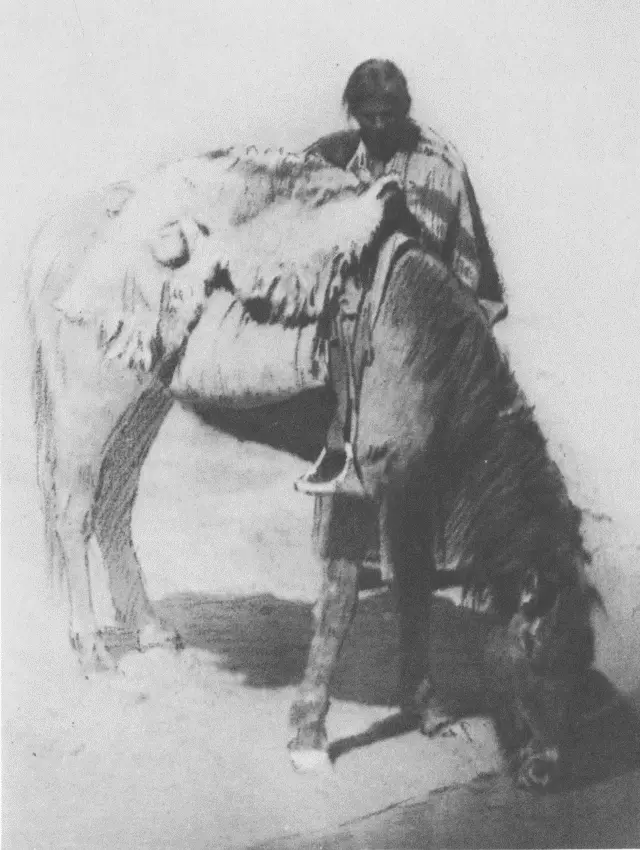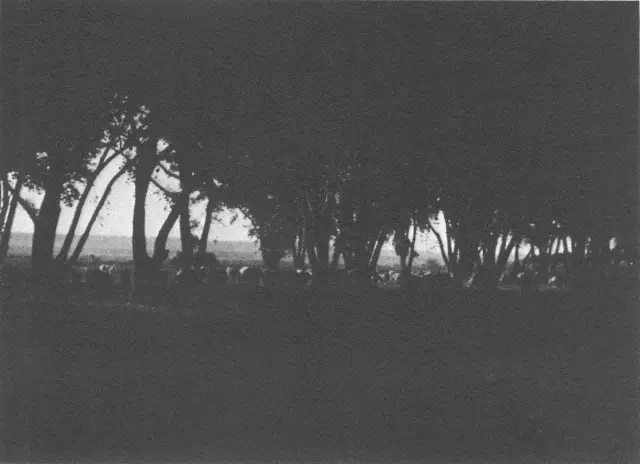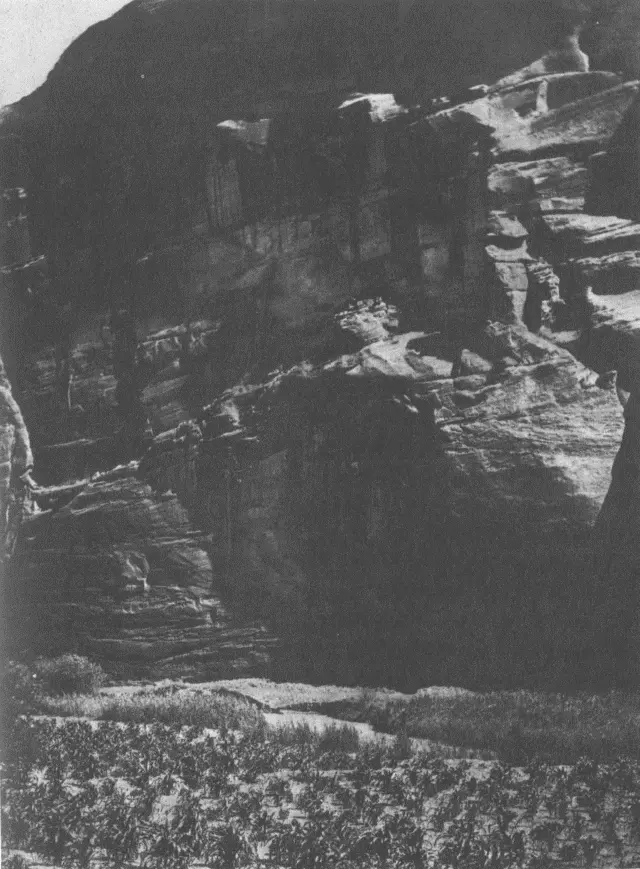Bat came up, flying round and round the rock. On his back was a basket, supported from his shoulders by two cords that looked like Spider's thread.
"That will not hold me!" exclaimed Nayé̆nayĕzganĭ.
"But it will," answered Bat; "it will hold the biggest of mountain sheep!" And to prove the truth of his assertion he filled the basket with stones and jumped up and down, and the threads held. Then Nayé̆nayĕzganĭ was satisfied and got in, and Bat began the descent. "Don't open your eyes!" he commanded. After a long time, feeling that they must be near the bottom, Nayé̆nayĕzganĭ opened his eyes, but the sight made him dizzy, and he almost fell out of the basket. Bat became angry at this, for the lurch almost threw him from the rock. At last, however, they reached the ground in safety.
There they dragged the bodies of the two great Eagles together, plucked them, and filled Bat's basket with the feathers, which Nayé̆nayĕzganĭ wished to take home. "Don't go in the low places," he advised Bat, as the latter started on ahead. But Bat forgot, and because the walking was easier went across the low places, where the birds stole all the feathers for their nests; so he had to return and fill the basket again. These he carried safely to Yólkai Ĕstsán, who gave many of them to the people of the village.
From Chunnaái, Nayé̆nayĕzganĭ learned of one more monster on the earth, a huge Rolling Stone, which lived in the south near the pueblo of Picuris; so he and his mother went southward. They stopped in a cañon through which Rolling Stone often passed on its way to and from the village, and by and by it came crashing along, destroying everything in its path. Just as it passed, Nayé̆nayĕzganĭ shot with one of his great flint-pointed arrows and shattered it, as he had shattered the tree when Chunnaái first gave him his weapons; and the ground in that spot is still red from the blood that flowed from Rolling Stone's heart.
Table of Contents
Black Man, Haschí̆n Dí̆lhĭli, was created by Nayé̆nayĕzganĭ to be his helper in the task of making the earth a good dwelling-place for the people. Haschí̆n made the animals, mountains, trees, and rivers, gave the people weapons and implements, and showed how they were to be used. When all were supplied with houses to live in and weapons with which to protect themselves and to kill game, he called Coyote, Tsilité̆n, the Mimic.
"Go to the Land of the Fireflies," he commanded, "and bring back their fire, for the people have no fire with which to cook their food."
Coyote started, and found the Land of the Fireflies. These beings lived at the bottom of a deep, deep hole—an enormous cave in the solid rock. Its sides were smooth and straight, and how to get down Coyote did not know. He went to the edge of the pit, and there found growing Little Tree.
"Help me down to the Land of the Fireflies," he said. So Little Tree sent its roots down, down, down, until they extended quite to the bottom, and Coyote descended. There he played with the little Firefly boys, romping about, running back and forth, pretending to be thinking of nothing but their amusement, for the Fireflies guarded their fire carefully and would let no one touch it.
On the tip of his tail Coyote had tied a tuft of cedar bark. Suddenly he dashed through the great fire which always burned in the centre of the village, and was off before the Firefly people knew what he had done. When they discovered that he had stolen some of their fire, they set out in pursuit; but Coyote was very swift of foot, and reached the wall of the pit far ahead of them.
"Little Tree, help me out!" he called.
Little Tree drew its roots up, up, up, while Coyote held on and was drawn safely out of the hole. Then he ran quickly about among the people, lighting the piles of wood they had prepared, until every family was supplied with fire.
Table of Contents

A Drink in the Desert - Navaho
From Copyright Photograph 1904 by E.S. Curtis
Home Life, Arts, and Beliefs
Table of Contents

Under the Cottonwoods - Navaho
The Navaho are a pastoral, semi-nomadic people whose activities centre in their flocks and small farms. Their reservation of more than fourteen thousand square miles is the desert plateau region of northern Arizona and New Mexico. Its mesas and low mountains are sparsely covered with piñon and cedar, and on the higher levels are small but beautiful forests of pine. Back and forth in all parts of this vast region the Navaho drive their flocks. At the season when the slight rainfall produces even scant pasturage on the desert plains the flocks are pastured there; but as the grass becomes seared by the summer sun and exhausted from pasturing, the flocks are taken into the mountains, where the shade of the pines lends grateful coolness. Again, as the deep snows of winter come, the sheep and goats are driven down to the wooded mesas, where there is little snow and an abundance of fuel, of which there is none on the plains. And so, year in, year out, the flocks slowly drift back and forth from plain to mesa and from mesa to mountain.
While the Navaho leads a wandering life, the zone of his movements is surprisingly limited; indeed the average Navaho's personal knowledge of his country is confined to a radius of not more than fifty miles. The family usually has three homes, the situation of which is determined by the necessities of life. Near their summer home they cultivate small crops of corn and vegetables in narrow, sandy washes, where by deep planting sufficient moisture is insured to mature the crop. In a few sections small farming is conducted by means of irrigation. In Cañon de Chelly, which may be termed the garden spot of the reservation, there are diminutive farms and splendid peach orchards irrigated with freshet water. The cañon drains an extensive region, and even a light rain causes the stream which flows at the base of its lofty walls to become swollen. This water the natives divert to their miniature cornfields and orchards, one or two freshets assuring good crops.

Cornfields in Canon Del Muerto - Navaho
Owing to its lowness and its earth covering, the Navaho house, or hogán, is the most inconspicuous of habitations. One might ride from morning till night across the reservation and not observe either a hogán or an Indian, although he has no doubt passed within a stone's throw of many of these houses and been peered at by many more dark eyes from brush concealments. At the end of a long day in the saddle the traveller may wonder where the many thousands of Navaho reside; but his inquiry may be answered if he will but climb to the summit of one of the many low mountains and view the panorama as the long shadows of evening are creeping on. Here and there in every direction the thin blue smoke of the campfire may be seen curling upward as these desert people prepare their evening meal. In this clear, rare atmosphere the far distant horizon is the only limit to his vision. Just below, a mile or so away, may perhaps be seen the smoke from a group of half a dozen hogáns. Miles beyond is another group, and still beyond another, and so throughout the sweep of vision. These people and their life are delightfully Indian, but slightly influenced by the white man's ways. As the chief human touch of the great southwestern desert the Navaho are the artist's joy, and as a subject for the ethnologist their ceremonial life furnishes limitless material for study.
Читать дальше















